Introduction
Galaxy formation and evolution is mainly entails the physical processes that resulted to the establishment of a non-uniform universe from a homogeneous start. How the first galaxies were formed and the way that they have evolved and the physical processes that have resulted to diverse structures in the adjacent galaxies form the basis of the theories that attempt to explain how the galaxies were formed and their subsequent evolution (Alvio & Ralf 2005). Structure formation theories attempt to bring forth how the galaxies were formed, with galaxy formation being attributed to numerous quantum fluctuations after the onset of the Big Bang. This model of galaxy formation implies that clustering and merging explain how the various galaxies increase their mass, and also plays a significant role in determining the shape and the structure of the galaxy (Chaisson 2007). From the early studies regarding galaxies, astronomers have attempted to develop diverse models in order explain the formation and evolution of the galaxies. The technological advancement has facilitated the process of further research to have an understanding of the galaxies during their early developmental stages and their subsequent evolution. In the last 10 years, the deployment of technological equipments like the Hubble Space Telescope has enabled the research of galaxies that were present when the entire universe was approximately 10 percent of its present age (Choi 2007). This research has resulted to some evidence that can be applied in the quest for explaining the galaxy formation and evolution. The two principal theories relating to galaxy formation and evolution were suggested during the 1960s. Over time, observational evidence resulted to notable constraints of the proposed models for explaining the formation and subsequent evolution of galaxies. The significant challenge is that the theories are not in concurrence with the collected evidence from the galaxies. This paper explores the competing theories of how the galaxies evolved and whether galaxies can be formed with super-massive black hole.
The competing models of how galaxies formed and evolved over the years
According to the classical model, as depicted in the figure 1 below, galaxies are formed and evolved in the form of comparatively isolated bodies. In this approach, the evolution of galaxies takes place in a pre-determined manner that depends on the earlier conditions and very minimal impact on the state of the adjacent environment (Djorgovski 2001). The hierarchical model on the other hand suggests that the formation and subsequent evolution of galaxies take place in terms of successive mergers comprised of smaller bodies, and that the outcome of evolution is mostly determined by the surrounding environment that the galaxy inhabits. Irrespective of the controversy surrounding the theories, there is a general focus of research in the previous ten years that attempts to reconcile the conflicting models (Dressler 1996). The implication of this is the development of a potential model that integrates the two models. This approach has been subject to developments considering the collected evidence facilitated by the technological advancements.
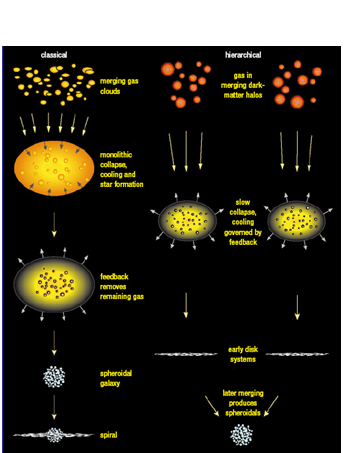
The Hybrid Hierarchical Model
The present understanding of how galaxies were formed and evolved has changed due to the various observations and evidence that has been collected during the last 10 years. Combining these observations result to the development of a hybrid hierarchical model (Ferguson 2001). This approach offers a logical explanation of the galaxies that have been observed, a significant limitation of this is that there is less certainty regarding numerical evidence. This approach is an integration of the models that are described in the figure 1 above. The structure of the model is outlined in the following figure 2.
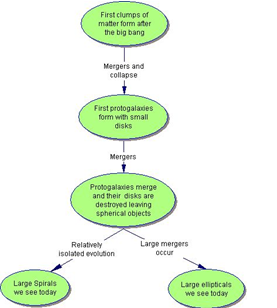
Under this hybrid approach, the formation of galaxies is presumed to have taken place from the earliest times during the existence of the universe. The Cosmic Microwave Background (CMB) radiation serves to be remaining radiation that can be observed after its emission at a period of approximately 300,000 years after the universe was born, which is usually referred to as the Big Bang. The miniature variations that are observed in the CMB radiation can be used to describe how matter is distributed in the universe. The variations in the early universe were somewhat clumpy. (Gibbons 1990 ) The various clumps of matter are presumed to have resulted to the formation of the cores of the initial galaxies, which were in the form of gas clouds that would subsequently evolve to form the galaxies that are observed in the present day universe.
The initial cloud gas galaxies are presumed to have merged to result to the formation of larger structures in the galactic universe. The formation of stars took place in the larger structures in the universe, and this resulted to the formation of the first population of galaxies. If merging took place between the newly formed galaxies during a time that they were still facing condensation and collapsing, this would have resulted to the formation of galaxies that are spheroid. Further condensation would result to the formation of galaxies that are spiral shaped (Houjun & White 2010). These spiral shaped galaxies are observed in the present day having central bulges that are spheroid, which is perceived to be the remnants of their form and shape in the past. This is shown in the figure 3 below (International Astronomical Union 2008).
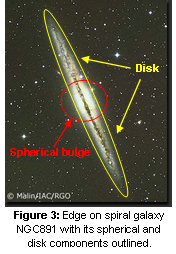
If merging would have taken place after the time that galaxies were condensing and condensing, then elliptical galaxies could have formed. This is shown in the following figure 4. The structures found in the galaxies that are spheroid in shape holds almost half of the stars that are found in the universe that can be observed; this offers valuable information concerning the manner through which the galaxies evolved (International Astronomical Union 2008).
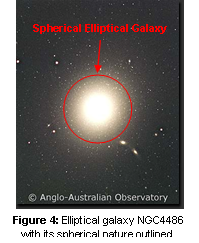
Most of the theoretical literature concerning the formation and evolution of galaxies has laid much emphasis on gaseous collapse. With regard to the hierarchical theory of the formation and evolution of galaxies, if there is an inward collapse of gas smoothly, there is slow formation of disks and stars. The merging of the disks would subsequently result to formation of spherical galactic structures in the universe, if the gas is not adequate, a slow buildup would again result to the formation of a disk. The stronghold of this approach to galaxy formation and evolution is that it attempts to explain the observable differences that are evident in the diverse kinds of galaxies that are observed in the course of the history of the universe (International Astronomical Union 2008). This is mainly because there is no single time when the different galaxies formed and subsequent evolution in the course of their existence. There are two primary factors when establishing a theory that can be used to explain how the galaxies were formed and evolved. The first prerequisite is to understand the star formation rate for the various galaxies (Jones & Adams 2004). The second requirement is to understand the various dynamics of the physical processes that result to the diverse forms that are observed in the present day universe. Developing a theory can facilitate the process of making predictions of the two factors can help astronomers in evaluating the accuracy of the theories relating to how the galaxies were formed and their subsequent evolution (Jones & Adams 2004).
Evidence
Dark Matter
Suspicion has been increasing since the 1930s regarding the visibility of the mass found in the universe. During 1980, there was supporting evidence claiming that the dark matter found in the universe could make up approximately 90 percent of the mass of the entire universe. According to the present theory, the dark matter is primarily made up of Cold Dark Matter, usually referred to as exotic particles. The deployment of models that rely on theories of Cold Dark Matter has been victorious towards prediction of the various features of the structures found in the universe. How the galaxy was formed and evolved is no exception and the Cold Dark Matter model is one of the best approaches to explain galaxy formation and its subsequent evolution from the early universe to their structural orientation of the present day galaxy (Tadayuki & Tōru 2008).
Before the Cold Dark Matter model, it was presumed that the formation of galaxies was based on the monolithic collapse approach. The following predictions in accordance with the Cold Dark Matter models and their concurrence with the current evidence are many, and this has attributed towards increased credibility of the hybrid hierarchical model (Tadayuki & Tōru 2008). Currently, this model is considered as the most successful and it is helpful in the prediction of hierarchical formation and diverse clustering within the universe (National Research Council (U.S.) 1991).
Small Blue Galaxies
Evidence collected from the HST equipment has made significant contributions towards the current understanding of how galaxies were formed and their subsequent evolutions. Most importantly, there was the discovery of new populations of galactic structures in the deepest images that were referred to as Hubble Deep Fields. The small blue galaxies as depicted in the figure 5 below serve to fill the early universe and were not observed in the present day universe (Liddle 2000). Their absence in the present day universe serves as potential evidence that can be deployed in the hierarchical model because the galaxies may have combined to result to the large galaxies that are observable.
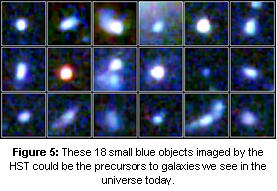
Potential evidence that offers support to the hybrid hierarchical model is the view that the blue galaxies were observed to be grouped in clumps that have adequate mass needed for the establishment of typical galaxies that are present in the modern day universe. However, not all the theories are in concurrence with the hierarchical model. Studies have reported that that the blue galaxies are constituents of the larger galaxies who visibility was due to high rates of star formation. In case this observation is true, then the larger galaxies are in concurrence with the theory of monolithic collapse (National Research Council (U.S.) 1991).
The differences in the galaxies over time
The diverse studies regarding the different types of galaxies found in the clusters have reported diverse outcomes that are in favor of both the hierarchical and the classical models of how the galaxy was formed and evolved. During the period when universe was approximately 30 percent of the young clusters were mainly dominated by galaxies that are spiral shaped (Richtler 2008). It cannot be simply concluded spiral galaxies can combine to give birth to elliptical galaxies. This state of affairs is adequately explained by hybrid hierarchical model because it attempts to explain how the early universe was formed through a process of monolithic collapse and how the spiral galaxies evolved to elliptical galaxies through a merger process that is hierarchical (International Astronomical Union 2008).
Star Formation Rate
Hot young stars are constantly emitting most of their energy in the form of Ultra Violet light, implying that recognition of their comparative brightness can be deployed to track the Star Formation Rate. Most of the surveys that have been done in the recent past to investigate the Star Formation Rates (SFR) reveal that there is compelling evidence that there has been evolution of galaxies over the course of their existence. One of the significant concerns regarding the study of Star Formation Rates is to determine which era the SFR was at its peak. There is uncertainty regarding this issue because there are numerous complications regarding the various factors involved such as extermination by dust (Tadayuki & Tōru 2008). There is a possibility that the peak era could have taken place in the recent past, and that there is a probability that it has not been seen yet. Owing to the fact that hierarchical model attempts to investigate and forecast that galaxies are formed from the merging of protogalaxies that are relatively smaller in size. This is likely to equate to the decrease in the solid line as depicted in the graph found in figure 6 below. However, this cannot be used to conclude because there are diverse effects like dust obscuration that can result to reduced detection (Spinrad 2005).
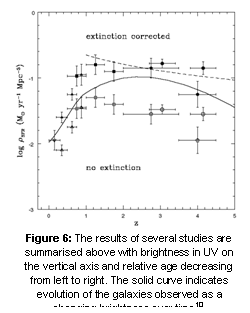
Further work
The evidence for both the competing models that explain how the galaxies were formed and evolved has been found in most of the surveys (Gibbons 1990 ). The effectiveness and accuracy of the Cold Dark Matter model predictions, the propagation of relatively small galaxies within the early galaxy, the changes in the galaxies over time and the differences in the Star Formation Rate over time all support the hierarchical model concerning how the galaxies were formed and their subsequent evolutions. There is also diverse evidence that is in support of the monolithic collapse. It is arguably evident more work is required to resolve the inconsistencies in the competing models of how galaxies were formed and their following evolutions (Dressler 1996).
The various uncertainties concerning history of galaxies are because of the differing methods and techniques that are used to collect evidence. The deployed techniques and approaches entail numerous complications that require to in depth analysis and improvements in technology to ensure that the observations are more sensitive and accurate. An improvement on the quality of evidence implies that there will be efficiency in evaluating the concurrency of the various competing models and ruling out any disparities in the theories (Houjun & White 2010).
The most important factor in the quest to have an understanding of how galaxies were formed and their following evolution over time is the ability to gather evidence from the various galaxies spread across the history of the universe by deploying equipment’s such as the HST. Gradual technological improvement has facilitated the discovery of the history of galaxies from the early universe to the universe as it is observed in the universe of today. New observations can be facilitated through the use of Spitzer Space Telescope and the Atacama Large Millimeter Array, which will be used to offer further data in order clarify the disparities in the competing models to have a better understanding of how the galaxies were formed and evolved (Choi 2007).
Conclusion
The astronomers have made significant contributions that have been aimed at understanding the way through which the galaxy was formed and its subsequent evolutions. It is arguably evident that the hybrid hierarchical model offers a viable explanation that can be used to have an understanding of how galaxies were formed and evolved because the model offers a quantitative explanation of the galaxies that have been observed. The present observations of the universe can be traced back to a time when the universe was only 10 percent of its present age. Improvements in technology help in enhancing the sensitivity and resolution of the evidence, which can be helpful in further investigation of theories relating to how galaxies were formed and their subsequent evolutions.
References
Alvio, R & Ralf, B 2005, Multiwavelength mapping of galaxy formation and evolution: proceedings of the ESO Workshop Held at Venice, Italy, 2003, Springer, New York.
Chaisson, E 2007, Astronomy: a beginner’s guide to the universe, Pearson/Prentice Hall, New York.
Choi, J 2007, The dynamics of satellite and dark matter halo interactions on galaxy formation and evolution, ProQuest, New York.
Djorgovski, S 2001, Encyclopaedia of Astronomy and Astrophysics, Institute of Physics Publishing, New York.
Dressler, A 1996, The Origin and evolution of the universe, Jones and Bartlett Publishers, Sudbury Massachusetts.
Ferguson, H 2001, Encyclopaedia of Astronomy and Astrophysics, New York, Institute of Physics Publishing.
Gibbons, W 1990, The Formation and evolution of cosmic strings: proceedings of a workshop supported by the SERC and held in Cambridge, 1989, CUP Archive, New York.
Houjun, M & White, S 2010, Galaxy Formation and Evolution, Cambridge University Press, Cambridge.
International Astronomical Union 2008, Formation and evolution of galaxy bulges: proceedings of the 245th Symposium of the International Astronomical Union held in Oxford, United Kingdom, 2007, Cambridge University Press, Cambridge.
Jones, M & Adams, J 2004, An introduction to galaxies and cosmology, Cambridge University Press, Cambridge.
Liddle, A 2000, Cosmological Inflation and Large-Scale Structure, Cambridge.
National Research Council (U.S.) 1991, Working papers: astronomy and astrophysics panel reports, National Academies Press, Washington.
Richtler, T 2008, Globular Clusters – Guides to Galaxies: Proceedings of the Joint ESO FONDAP Workshop on Globular Clusters Held in Concepción, Chile,2006, Springer, New York.
Spinrad, H 2005, Galaxy formation and evolution, Springer, New York.
Tadayuki, K & Tōru, Y 2008, Panoramic views of galaxy formation and evolution: proceedings of a conference held at Shonan Village Center, Hayama, Japan, 2007, Astronomical Society of the Pacific, Tokyo.